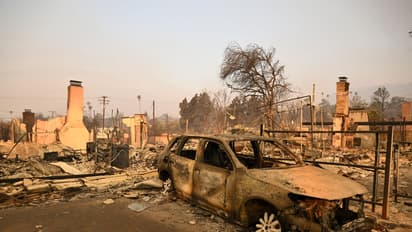Los Angeles wildfires projected to cause $150 billion in damages, insurance industry braces for impact

Synopsis
The devastating wildfires sweeping through Los Angeles County are now being labeled as one of the costliest natural disasters in modern US history.
The devastating wildfires sweeping through Los Angeles County are now being labeled as one of the costliest natural disasters in modern US history. In just 24 hours, AccuWeather revised its damage estimates for the fires from $57 billion to a staggering $150 billion, highlighting the massive economic toll of the catastrophe.
“These fast-moving, wind-driven infernos have created one of the costliest wildfire disasters in modern US history,” said Jonathan Porter, AccuWeather's chief meteorologist. The fires have destroyed entire communities and left a lasting mark on areas renowned for their multimillion-dollar properties.
Los Angeles wildfires cause widespread destruction
The Palisades Fire alone has obliterated over 5,300 structures, while the Eaton Fire has damaged or destroyed an additional 4,000 to 5,000 buildings. Both fires continue to rage, exacerbated by hurricane-force winds that are spreading the flames at alarming speeds.
The affected areas include some of the wealthiest neighborhoods in the country, adding significantly to the financial toll. Luxury homes, commercial buildings, and critical infrastructure have all fallen victim to the flames.
California insurance crisis decoded
The California insurance crisis highlights the growing struggle homeowners face in obtaining and maintaining property insurance, particularly in high-risk wildfire areas. For years, California was the only state that prohibited insurers from passing certain costs onto policyholders, according to NBC. However, with wildfires becoming more frequent and severe due to climate change, many insurers are drastically raising premiums or refusing to cover properties altogether.
This shift has left thousands of homeowners vulnerable, scrambling to secure adequate protection for their properties.
California's Fair Access to Insurance Requirements (FAIR) Plan, established in the 1960s, offers basic fire insurance coverage for high-risk properties. Funded by insurance companies, it was designed as a last resort. However, its use has skyrocketed in recent years, with residential policies surging from 154,500 in September 2019 to over 408,400 by June 2024. State officials warn that this growing reliance on the FAIR Plan has created an unsustainable level of exposure for the program.
The crisis has been compounded by major insurance providers pulling back from California. In 2023, State Farm, the state’s largest property insurer, announced it would no longer issue new homeowner policies, citing factors such as increased catastrophe exposure. Allstate, California's sixth-largest home insurer, followed suit the same year, halting new policies for similar reasons. In high-risk areas like Pacific Palisades, State Farm dropped approximately 1,600 policies last year alone, leaving homeowners in some of the state's most wildfire-prone regions with limited options.
Reinsurance, a critical component of the insurance ecosystem, is also being affected by escalating wildfire risks. Reinsurers, who provide coverage to primary insurers to help manage large losses, are increasingly cautious about operating in California. This has further tightened the availability of insurance policies, forcing many homeowners to either pay exorbitant premiums or risk going uninsured.
Palisades fire poised to become one of the state's costliest
The financial toll is staggering. Analysts from Morningstar and JP Morgan predict that insured losses could exceed $8 billion, while the overall economic impact of the fires continues to rise.
JP Morgan analysts told NBC that the area of the Palisades Fire is "an affluent residential area, with a median home price" exceeding $3 million.
Notably, analysts say that California might pay anywhere from $1,000 to upward of $40,000 a year to insure their properties.
Check the Breaking News Today and Latest News from across India and around the world. Stay updated with the latest World News and global developments from politics to economy and current affairs. Get in-depth coverage of China News, Europe News, Pakistan News, and South Asia News, along with top headlines from the UK and US. Follow expert analysis, international trends, and breaking updates from around the globe. Download the Asianet News Official App from the Android Play Store and iPhone App Store for accurate and timely news updates anytime, anywhere.